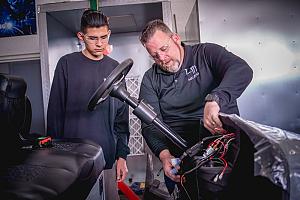Contributing Writer
- FMA
- The Fabricator
- FABTECH
- Canadian Metalworking
Categories
- Additive Manufacturing
- Aluminum Welding
- Arc Welding
- Assembly and Joining
- Automation and Robotics
- Bending and Forming
- Consumables
- Cutting and Weld Prep
- Electric Vehicles
- En Español
- Finishing
- Hydroforming
- Laser Cutting
- Laser Welding
- Machining
- Manufacturing Software
- Materials Handling
- Metals/Materials
- Oxyfuel Cutting
- Plasma Cutting
- Power Tools
- Punching and Other Holemaking
- Roll Forming
- Safety
- Sawing
- Shearing
- Shop Management
- Testing and Measuring
- Tube and Pipe Fabrication
- Tube and Pipe Production
- Waterjet Cutting
Industry Directory
Webcasts
Podcasts
FAB 40
Advertise
Subscribe
Account Login
Search
Are you preparing for the worker skills gap?
- By Michael Long
- March 7, 2006
- Article
- Shop Management
 |
The pressure is on. Truly, finding and keeping skilled workers will become one of your greatest hurdles in running a successful business in the coming decade, if it isn't already. It's a double whammy: Not only are skilled workers hard to find, but in a leaner and meaner working environment, you need and expect more from your employees than you did just a few years ago.
A "perfect storm" is approaching North American fabricators and manufacturers. This storm is a skills gap— a situation in which the knowledge and skills of the available work force do not meet employers' needs.
Although all industries in North America will experience this phenomenon—mainly because mass numbers of boomers soon will retire—industries that need technically skilled and educated workers are going to feel the greatest impact. The shortage of students in technical, engineering, mathematical, and scientific fields, in addition to the low supply of youth receiving valuable training in trades such as welding, will hit manufacturing and job shops particularly hard.
This storm grows bigger and bigger as it's fed by a number of factors, including:
- An increasingly negative image of manufacturing portrayed by popular media, that focuses on Big Three layoffs rather than small-business successes
- Drastic demographic shifts in the work force as boomers retire and non-English-speaking workers become the majority in some regions
- Increasing demand for a better-educated labor force at the same time greater pressure is placed on existing employees to be more efficient
- Anticipated healthy manufacturing production for North America
Common Themes
I've met many people involved in metal manufacturing, both face-to-face at conferences and over the phone. In conversations I've noticed a couple of common themes. The first, and one you may be thinking yourself, is retirement: "I am going to retire soon. They're just asking too much of me and I'm tired!" And let's face it, many in today's work force simply are in the age group for retirement.
The second theme I hear repeatedly reflects a lack of time and resources for training current workers. Staff levels have been reduced, business has picked up, and even if companies have the money, they just don't have time to spare for workers to be away from the production line. At a roll forming workshop last fall, I met a guy who used his vacation time to attend the program. "My company has registered me for this workshop the past two years, and each time they pulled me back at the last minute. I wanted to go, so I just took vacation to make sure I could come this year."
True, in a perfect world companies would have all the staff necessary and the time to train them; but companies have had to go lean in order to survive. Hiring more staff is a pipe dream, because people just cost too much money. However, there comes a time when businesspeople have to ask themselves how much mistakes cost, especially with the price of steel these days. And they must assess how detrimental poor productivity, overloading or overworking their employees, or "just doing it myself" truly is.
Sobering Numbers
In an article last April, I mentioned that by 2008 the number of young adult workers in the U.S. 25 to 40 years old will decline by 1.7 million just as 77 million baby boomers become eligible for retirement. The real impact of boomer retirement is expected to start having major a impact around 2010-2013. Yeah, so that's four years away; big deal, right? Well, it isa big deal. Why do I keep harping on this? Well, let's look at the situation as it currently stands.
According to the 2005 Skills Gap Survey of the American Manufacturing Workforce (Deloitte and the Manufacturing Institute, 2005), 81 percent of respondents said they couldn't find qualified workers to fill their open positions. And according to CNNMoney.com, one of the top five careers demanding big money is manufacturing engineer. Even with all the downsizing in the automotive sector, plant managers certified in lean manufacturing, quality and process engineers, and product engineers are hot commodities.
Addressing the Skills Gap
First, don't ignore the skills gap. Second, assess your needs. Third, prepare a plan.
Don't Ignore It. It's frustrating to know you need to prepare a long-term strategy when your company's focus is on the here and now, and possibly next quarter. But some basic, simple efforts now will pay off with big dividends.
Assess Your Needs. It's time to really stop and think about your work force now and where will it be in, say, three, five, or 10 years down the road. Assess what your current needs are, and project what levels of staff you'll need. Also, take an honest look at the staff you have, and estimate your turnover over the next 10 years.
Prepare a Plan. Hiring and keeping the best employees sounds like a great strategy, but accomplishing it can seem nearly impossible. It can be frustrating to invest time and money in staff only to see your competitors snatch them up. Retention is a challenge, and it is going to become more of one. To address retention, instead of thinking of employees as a group, you'll have to think about them as individuals, with individual desires, needs, and wants.
As your work force diversifies to include new generations and cultures, its needs, wants, and desires will differ from previous employees'. Traditional forms of compensation may not be the employee's primary motivation for working for you. Some more nontraditional wants you may encounter include working a flex-time schedule, flexible compensation programs, working for an ethical employer (the Enron factor), and a healthy and positive working environment.
Bridging the Gap
My initial guess is, yes, you need engineers. But what I bet you really need is a good welder or a smart person to run that million-dollar machine you just bought. These workers, unlike engineers, most likely will come from your regional population. So take an active role in your community's education initiatives. Make sure your local business community is involved and monitoring the K-12 system initiatives in math, science, and technical curricula. Invite a class into your shop to see how cool a 3-D laser cutter really is. Make sure your local elected officials know you exist. Participate in your Chamber of Commerce, and if it doesn't have a manufacturing networking group, start one.
Take steps to partner with your local trade school or community college. If enough companies represent sufficient regional demand, these schools might develop programs specifically for the organizations. I frequently hear from fabricators that their staff needs better math, computer, and blueprint-reading skills. These are common programs that should be readily available. If you have workers willing to go for training, pay for it. Offer it as a benefit to all staff. You'll see payback in better performance—and loyalty as well.
Another way to cope with the talent loss from retirees is to negotiate a gradual exit for them. Many contemplating retirement would like to remain involved, but no longer want to work 40+ hours a week. These individuals may be interested in part-time work as long as it's based on their schedule. Be open and proactive with them; before they decide on a retirement date, offer part-time work as an option. Also, let potential retirees know that once they've retired, your doors are open should they wish to reconsider. Upon retiring, many people "vacation" for an extended period; when boredom sinks in, they seek a part-time job to keep them busy and mentally engaged.
Ultimately, you will need to invest in training. It's the only way to deal with a skills gap. Whether through a local community college or trade school, by implementing in-house training, or by sending your employees to association workshops or certification programs, training will be your key to surviving the coming storm.
About the Author
subscribe now

The Fabricator is North America's leading magazine for the metal forming and fabricating industry. The magazine delivers the news, technical articles, and case histories that enable fabricators to do their jobs more efficiently. The Fabricator has served the industry since 1970.
start your free subscription- Stay connected from anywhere

Easily access valuable industry resources now with full access to the digital edition of The Fabricator.

Easily access valuable industry resources now with full access to the digital edition of The Welder.

Easily access valuable industry resources now with full access to the digital edition of The Tube and Pipe Journal.
- Podcasting
- Podcast:
- The Fabricator Podcast
- Published:
- 05/14/2024
- Running Time:
- 62:12
Cameron Adams of Laser Precision, a contract metal fabricator in the Chicago area, joins the podcast to talk...
- Trending Articles
What software automation means for custom fabrication

Why employee-owned companies make sense in manufacturing

Nucor’s weekly steel price announcement continues to rattle markets

Press brakes, panel benders, and flat blank calculations

Washington artist creates life-size elk sculptures

- Industry Events
Laser Welding Certificate Course
- May 7 - August 6, 2024
- Farmington Hills, IL
World-Class Roll Forming Workshop
- June 5 - 6, 2024
- Louisville, KY
Advanced Laser Application Workshop
- June 25 - 27, 2024
- Novi, MI
Precision Press Brake Certificate Course
- July 31 - August 1, 2024
- Elgin,


























